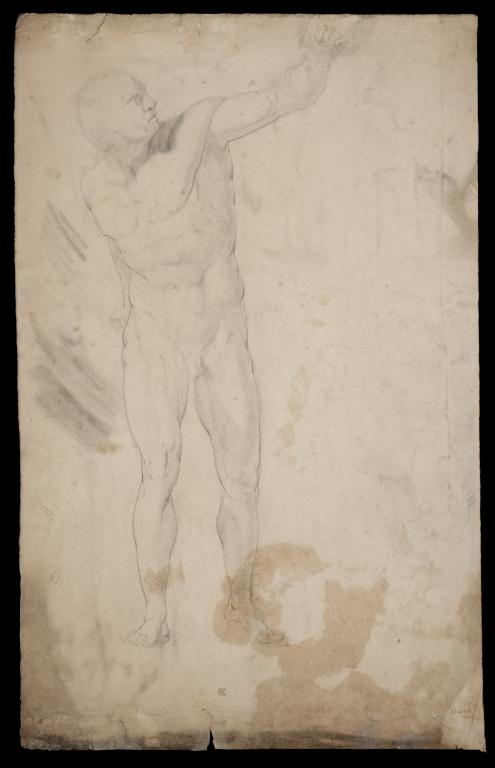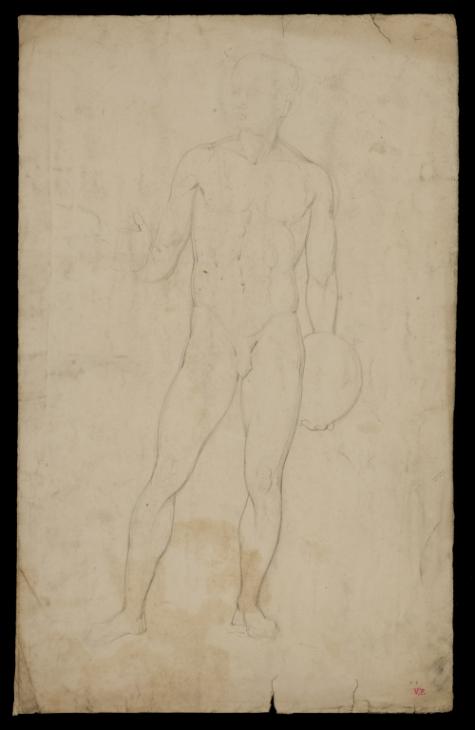J.M.W. Turner
>
1787-1801 Student and master
>
Royal Academy c.1789-99
>
Studies from the Antique and Other ...
>
Artwork
23 of 24 artworks
Joseph Mallord William Turner Full-length Study of the Fighting Gladiator c.1791
Image 1 of 2
Joseph Mallord William Turner,
Full-length Study of the Fighting Gladiator
c.1791
Joseph Mallord William Turner 1775–1851
Full-length Study of the Fighting Gladiator c.1791
D40219
Pencil and black chalk with stump on white wove paper, 440 x 277 mm
Stamped in brown ink with Turner Bequest monogram bottom centre
Stamped in brown ink with Turner Bequest monogram bottom centre
Accepted by the nation as part of the Turner Bequest 1856
References
1909
A.J. Finberg, A Complete Inventory of the Drawings of the Turner Bequest, London 1909, vol.I, p.8 under V P, as ‘On back, Fighting Gladiator’.
Technique and condition
This is a double-sided graphite pencil drawing dating from Turner’s time as an art student at the Royal Academy. The sheet is a hand-made cream coloured wove paper. The right-hand edge of the recto is deckled, which means that this was the outer edge of a larger handmade sheet, now cut down. The bottom edge has been very unevenly cut. These are early drawings and the style is linear and tentative. The outline of the figures was drawn first. The block shading used on the verso was then added afterwards by smudging chalk dust to create soft, solid areas of shading.
Heavy surface dirt is evident on both recto and verso of the work. There is severe oil-based staining (possibly linseed oil since he used it for all colours of paint, even white and pale blue, in contrast to the received wisdom of using walnut or poppy oil which yellow less and give less of a colour cast to the paint) along the bottom of the sheet. This was probably caused by the sheet having been stored in the artist’s studio for a considerable period. There is also a rust coloured adhesion (to a neighbouring sheet of paper) in the centre of the recto. These stains constitute part of the history of the sheet and would not be considered for conservation treatment to reduce their impact, even if they obscured the drawing more than they in fact do.
There are several tears along both the top and bottom edges of the sheet and at some point these were repaired using pressure sensitive tape on the verso. This tape – not unexpectedly since it is a poor choice of material for repairing paper – degraded over time, and damaged the paper by making it discolour to brown. In 2008 the tape and its adhesive were removed and the tears were repaired again using Japanese tissue, toned to match the present colour of the undamaged though somewhat dirty paper, and adhered in place with wheat starch paste.
Helen Evans
June 2009
Revised by Joyce Townsend
February 2011
How to cite
Helen Evans, 'Technique and Condition', June 2009, revised by Joyce Townsend, February 2011, in Andrew Wilton, ‘Full-length Study of the Fighting Gladiator c.1791 by Joseph Mallord William Turner’, catalogue entry, April 2012, in David Blayney Brown (ed.), J.M.W. Turner: Sketchbooks, Drawings and Watercolours, Tate Research Publication, December 2012, https://wwwLike the drawing on the recto (D00068; Turner Bequest V P), this is an outline study, though here Turner has amplified it by using a stump to create areas of tone. There are stump trials to the left of the image. For other studies of the Borghese Gladiator see Tate D00069, D00070 and D00071 (Turner Bequest V R, Q, S).
The recto of this sheet is D00068 (Turner Bequest V P).
Andrew Wilton
April 2012
How to cite
Andrew Wilton, ‘Full-length Study of the Fighting Gladiator c.1791 by Joseph Mallord William Turner’, catalogue entry, April 2012, in David Blayney Brown (ed.), J.M.W. Turner: Sketchbooks, Drawings and Watercolours, Tate Research Publication, December 2012, https://www


